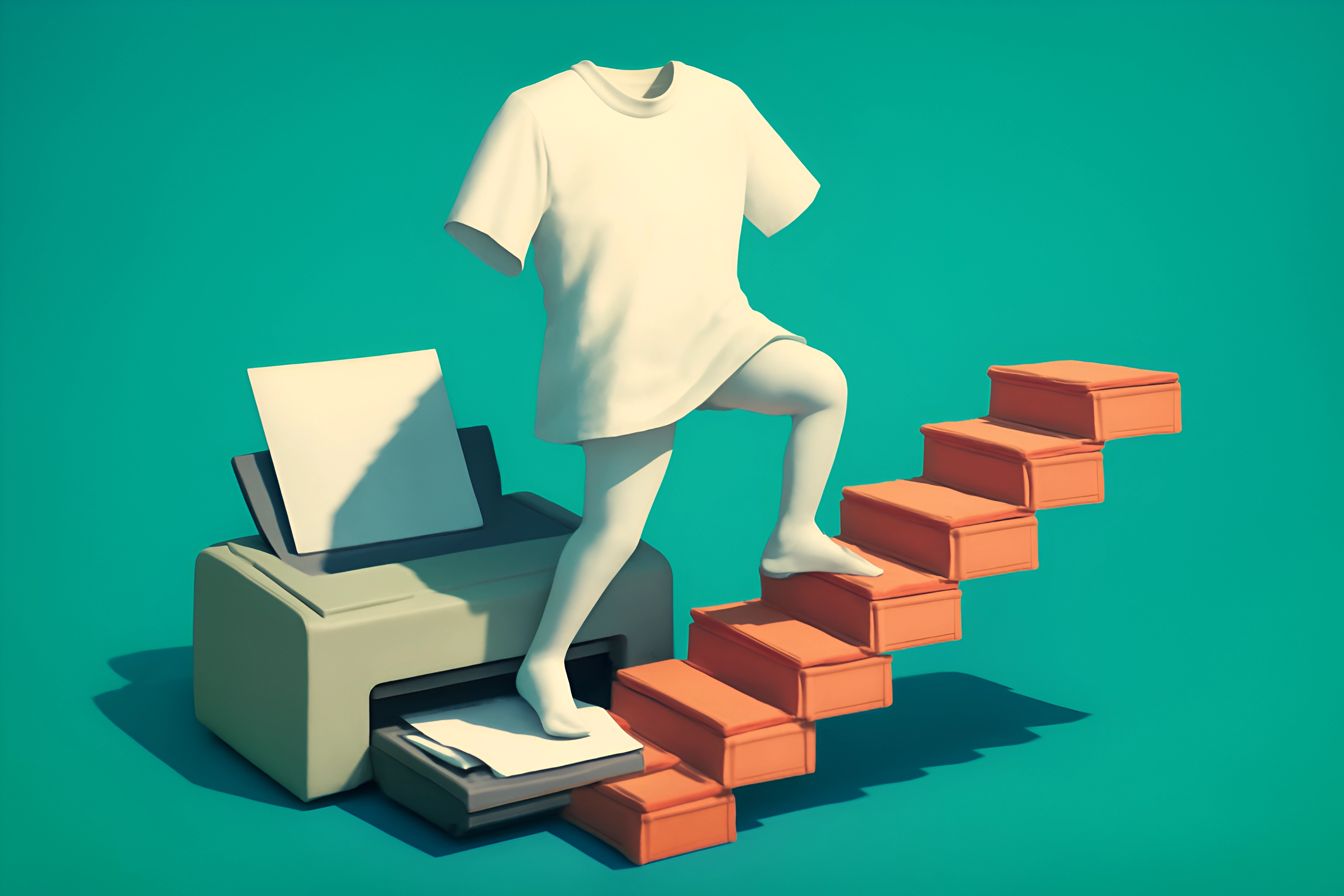
Ever wished you could run a creative business without a garage full of inventory or a huge upfront investment? What if you could sell custom t-shirts, mugs, and posters from your couch after your day job, turning your unique ideas into a real source of income? You’re not alone in this dream; in 2022, a staggering 40% of Americans had a side hustle, all seeking more financial freedom and creative control.
The answer isn't some complicated, high-risk venture. It's a business model called Print-on-Demand (POD), and it’s the perfect entry point into e-commerce for ambitious people just like you. It allows you to monetize your creativity with minimal overhead, letting you focus on what you do best—coming up with great ideas.
This isn't a 'get rich quick' scheme. This is your realistic, no-fluff roadmap to starting a print-on-demand shop as a side hustle. We'll walk you through every single step, from finding your first winning idea to making your first sale, all while helping you balance your precious time and energy. Your journey to building something you own starts right now.
What is Print-on-Demand (and Why It’s Perfect for a Side Hustle)?
So, what exactly is this magic? At its core, print-on-demand is a business model where you work with a supplier to sell custom-branded products with your own designs. The best part? The products are only created after a customer places an order. This completely eliminates the financial risk of buying inventory upfront.
The process is beautifully simple and automated. You create a design, upload it to a product like a hoodie or a tote bag, and list it for sale in your online shop. When a customer buys it, the order is automatically sent to your POD partner, who then prints, packs, and ships the product directly to the customer under your brand. You just sit back and collect the profit.
This hands-off fulfillment process is what makes POD the ultimate side hustle. There are no boxes to store, no trips to the post office, and no unsold stock gathering dust. It’s a low-risk model that gives you the flexibility to test new ideas and build a brand from anywhere in the world, all you need is a laptop and a spark of creativity.
Step 1: Find Your Profitable Niche (The Foundation of Your Shop)
Let’s get one thing straight: trying to sell to everyone means you end up selling to no one. The secret to standing out in the crowded world of e-commerce is finding a specific, profitable niche. A niche is your tribe—a dedicated group of people passionate about something, whether it's "funny shirts for book lovers" or "minimalist art for rock climbers."
Drilling down into a niche allows you to connect with a passionate audience that is actively looking for products that speak to them. Think about the difference in power between a generic "dog shirt" and a "sassy corgi mom" t-shirt. The latter targets a specific identity and emotion, making it far more likely to convert. With 66% of U.S. households owning a pet, even a small slice of that market can be incredibly lucrative.
To find your niche, start by listing your own passions, hobbies, and professional expertise. What communities are you a part of? Then, use tools like Google Trends to check the popularity of your ideas and browse Etsy and Amazon to see what’s already selling. Look for trends in hobbies, professions, and pop culture to find an audience you can serve with unique designs.
Step 2: Create Your Designs (Even if You're Not a "Designer")
Do you freeze up at the word "designer"? Don't. Many of the best-selling print-on-demand products feature simple text-based designs or basic graphics. Perfection is the enemy of progress, and your goal is to create designs that connect with your niche, not to win a fine art award.
You have a powerful toolkit at your fingertips, even as a complete beginner. User-friendly platforms like Canva and Kittl offer thousands of templates and graphics that you can easily customize. For those with a bit more experience, Procreate or Adobe Illustrator offer limitless possibilities. You can even purchase pre-made graphics with commercial licenses from marketplaces like Creative Market to get started quickly.
Now for a crucial warning: you must respect intellectual property. Using popular movie characters, song lyrics, or brand logos is a fast track to getting your shop shut down. Before you use a phrase, always do a quick search on the USPTO's TESS database to ensure it isn't trademarked. Building a legitimate, long-lasting business means creating original work or using properly licensed assets.
Step 3: Choose Your Platform & POD Provider
With your niche and designs ready, it's time to build your digital storefront. You have two main paths, and the right one depends on your goals. For beginners, we strongly recommend starting with an established marketplace like Etsy. It comes with a massive, built-in audience of buyers, which solves the difficult problem of generating traffic from scratch.
The alternative is building your own storefront using a platform like Shopify. This gives you complete control over your brand and customer experience, but it means you are 100% responsible for marketing and driving every single visitor to your site. While it's a great long-term goal, starting on a marketplace like Etsy allows you to validate your ideas and make sales faster.
Next, you'll need to choose a print-on-demand provider to produce your products. These companies integrate with your chosen platform to automate the entire fulfillment process. Here are two of the most popular and reliable choices for beginners:
| Provider | Best For | Key Features |
|---|---|---|
| Printify | Variety & Competitive Pricing | Huge network of print providers, wide product catalog, easy integration with Etsy & Shopify. |
| Printful | Premium Quality & Reliability | High-quality in-house printing, excellent mockups, seamless integration, and branding options. |
TheEarnist Pro-Tip: Before you list a single item, you must always order samples. This is a non-negotiable step to verify the print quality, colors, and material feel of your products. Your customers deserve the best, and samples ensure you’re selling something you can be proud of.
Step 4: Set Up Your Shop & List Your First Product
This is where your vision starts to become a reality. Setting up your shop and creating your first product listing is an exciting step, and getting it right is key to making sales. Focus on creating a listing that not only looks great but is also optimized to be found by your target customers.
Your product title is your first and most important piece of SEO. Use keywords from your niche research to create descriptive, searchable titles like "Minimalist Wildflower Shirt, Book Lover Gift, Botanical Tee." In your description, don't just list features; tell a story. Who is this product for? What feeling does it evoke? Paint a picture that helps the customer see themselves wearing or using your item.
Finally, presentation is everything. Use the high-quality mockup images provided by your POD partner to show your designs on actual products. For an even bigger impact, consider using lifestyle mockups from services like Placeit to help customers visualize the item in a real-world setting. When it comes to pricing, use this simple formula to ensure you're profitable:
(Provider's Product Cost + Shipping) + Platform Fees + Your Desired Profit = Your Listing PriceStep 5: Market Your Side Hustle (The Smart & Sustainable Way)
You've built it, but will they come? As a side hustler, your time is your most valuable asset, so you can't afford to be everywhere at once. The key to sustainable marketing is to focus your energy on one or two channels where your niche audience spends their time.
For most visually-driven products, Pinterest is a powerhouse. It's not a social network; it's a visual search engine where users are actively looking for ideas and products to buy. You can even connect your Shopify store directly to Pinterest to create shoppable pins. For other niches, creating simple videos or reels for Instagram and TikTok showcasing your designs can be incredibly effective.
The most powerful marketing tool for anyone starting on Etsy is Etsy's own search engine. Your goal is to master Etsy SEO by using all 13 available tags on every listing. Use long-tail, descriptive keywords that a real customer would type into the search bar. To avoid burnout, adopt the "batching" method: spend one hour on a Sunday creating all of your social media posts and pins for the entire week. This is how you work smarter, not harder. Once you're ready to scale, you can explore more proven print-on-demand strategies to boost your earnings.
Your Journey Starts Now
You now have the complete roadmap. We've walked through the five essential steps: finding your niche, creating your designs, choosing your platforms, setting up your shop, and marketing your products. This is the blueprint for building a creative business on your own terms.
A successful print-on-demand shop is built one design, one listing, and one sale at a time. It's a marathon, not a sprint, but it is one of the most accessible and rewarding ways to build an income stream that gives you freedom and control. The power to turn your creativity into a source of recurring revenue is officially in your hands.
What's the first niche you're thinking of exploring? Share your ideas in the comments below—we'd love to cheer you on














